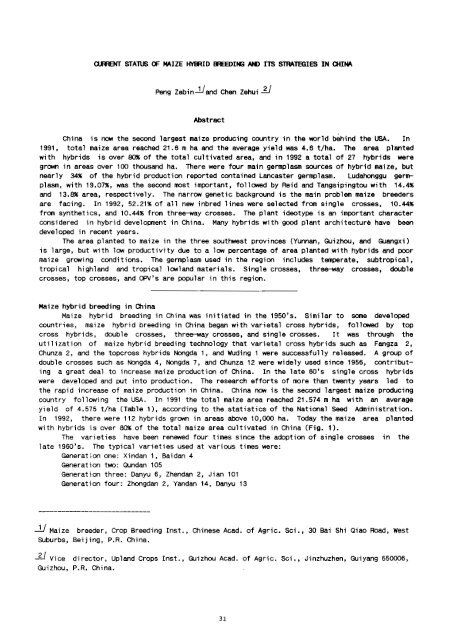Proceedings of the Fifth Asian Regional Maize Workshop - Search ...
Proceedings of the Fifth Asian Regional Maize Workshop - Search ...
Proceedings of the Fifth Asian Regional Maize Workshop - Search ...
You also want an ePaper? Increase the reach of your titles
YUMPU automatically turns print PDFs into web optimized ePapers that Google loves.
aRBff STAnJS OF MAIZE HYIIUD ER:EDIftG AN} IlS STRATEGIES IN am~<br />
Peng Zebin-Uand Chen Zehui.:£f<br />
Abstract<br />
China is now <strong>the</strong> second largest maize producing country in <strong>the</strong> world behind <strong>the</strong> USA. In<br />
1991, total maize area reached 21.6 m ha and <strong>the</strong> average yield was 4.6 t/ha. The area pl~ted<br />
with hybrids is over ~ <strong>of</strong> <strong>the</strong> total cultivated area, and in 1992 a total <strong>of</strong> 27 hybrids were<br />
grown in areas over 100 thousand ha. There were four main germplasm sources <strong>of</strong> hybrid maize, but<br />
nearly 34~ <strong>of</strong> <strong>the</strong> hybrid production reported contained Lancaster germplasm. Ludahonggu germplasm,<br />
with 19.07~, was <strong>the</strong> second most important, followed by Reid and Tangsipingtou with 14.4~<br />
and 13.8% area, respectively. The narrow genetic background is <strong>the</strong> main problem maize breeders<br />
are facing. In 1992, 52.21~ <strong>of</strong> all new inbred lines were selected from single crosses, 10.44~<br />
from syn<strong>the</strong>tics, and 10.44~ from three-way crosses. The plant ideotype is an important character<br />
considered in hybrid development in China. Many hybrids with good plant architecture have been<br />
developed in recent years.<br />
The area planted to maize in <strong>the</strong> three southwest provinces (Yunnan, Gui zhou , and Guangxi)<br />
is large, but with low productivity due to a low percentage <strong>of</strong> area planted with hybrids and poor<br />
maize growing conditions. The germplasm used in <strong>the</strong> region includes temperate, subtropical,<br />
tropical highland and tropical lowland materials. Single crosses, three-way crosses, double<br />
crosses, top crosses, and OPV's are popular in this region.<br />
<strong>Maize</strong> hybrid breeding in China<br />
<strong>Maize</strong> hybrid breeding in China was initiated in <strong>the</strong> 1950's. Similar to some developed<br />
countries, maize hybrid breeding in China began with varietal cross hybrids, followed by top<br />
cross hybrids, double crosses, three-way crosses, and single crosses. It was through <strong>the</strong><br />
utilization <strong>of</strong> maize hybrid breeding technology that varietal cross hybrids such as Fangza 2,<br />
Chunza 2, and <strong>the</strong> topcross hybrids Nongda 1, and Wuding 1 were successfully released. A group <strong>of</strong><br />
double crosses such as Nongda 4, Nongda 7, and Chunza 12 were widely used since 1956, contributing<br />
a great deal to increase maize production <strong>of</strong> China. In <strong>the</strong> late 60's single cross hybrids<br />
were developed and put into production. The research efforts <strong>of</strong> more than twenty years led to<br />
<strong>the</strong> rapid increase <strong>of</strong> maize production in China. China now is <strong>the</strong> second largest maize producing<br />
country following <strong>the</strong> USA. In 1991 <strong>the</strong> total maize area reached 21.574 m ha with an average<br />
yield <strong>of</strong> 4.575 t/ha (Table 1), according to <strong>the</strong> statistics <strong>of</strong> <strong>the</strong> National Seed Administration.<br />
In 1992, <strong>the</strong>re were 112 hybrids grown in areas above 10,000 ha. Today <strong>the</strong> maize area planted<br />
with hybrids is over 8~ <strong>of</strong> <strong>the</strong> total maize area cultivated in China (Fig. 1).<br />
The varieties have been renewed four times since <strong>the</strong> adoption <strong>of</strong> single crosses in <strong>the</strong><br />
late 1960's. The typical varieties used at various times were:<br />
Generation one: Xindan 1, Baidan 4<br />
Generation two: Qundan 105<br />
Generation three: Danyu 6, Zhendan 2, Jian 101<br />
Generation four: Zhongdan 2, Yandan 14, Danyu 13<br />
-!J <strong>Maize</strong> breeder, Crop Breeding Inst., Chinese Acad. <strong>of</strong> Agric. Sci., 30 Bai Shi Qiao Road, west<br />
Suburbs, .Bei j ing, P.R. China.<br />
-fJ Vice director, Upland Crops Inst., Guizhou Acad. <strong>of</strong> Agric. Sci., Jinzhuzhen, Guiyang 550006,<br />
Guizhou, P.R. China.<br />
31

















